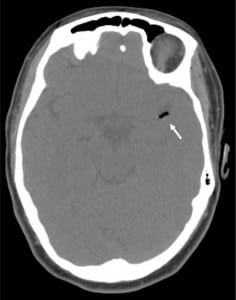| Author | Affiliation |
|---|---|
| Matthew C. DeLaney, MD | Maine Medical Center, Department of Emergency Medicine, Portland, ME |
| Christopher T. Bowe, MD | Maine Medical Center, Department of Emergency Medicine, Portland, ME |
| George L. Higgins, III, MD | Maine Medical Center, Department of Emergency Medicine, Portland, ME |
A previously healthy 38-year-old woman, with no significant past medical history, presented to the emergency department with acute onset of weakness after outpatient sclerotherapy. She had two milliliters of 0.5% foamed tetradecylsulfate injected into right lower extremity varicose veins. Twenty minutes after completion of the procedure, she had acute onset of right upper and lower extremity weakness. Computed tomography (CT) of the brain revealed gas within the distal left middle cerebral artery (Figure 1). She was treated with high flow oxygen via a non-rebreather facemask at 15 liters/minute. While transfer was being arranged to a facility with hyperbaric capabilities, her symptoms entirely resolved. Repeat neurologic examination 76 minutes after arrival revealed no residual deficits.

Complications from venous sclerotherapy involve pain at the site of injection, venous thromboembolism, improper injection into the arterial circulation and cutaneous necrosis.1 While localized complications following sclerotherapy are well documented, the incidence of these complications is rare. Systemic complications, such as the CVA presented above, are even less common. Case reports by Forlee1 and Hanisch2 document stroke after foam injection. Morrison3examined a group of 21 patients with symptoms of visual disturbance or headache after foam sclerotherapy. Echocardiography identified foam particles in the right heart in all patients within 10 to 30 seconds of injection. Seven of those patients were found to have a patent foramen ovale and four had high-intensity signals in the middle cerebral artery, suggestive of paradoxical embolism. While a definitive relationship between the procedure and the complication cannot be documented in our patient, the occurrence of an air embolism immediately following venous sclerotherapy would suggest a causal association between the two events. Emergency physicians should consider the possibility of paradoxical embolization in the setting of new onset neurologic symptoms associated with venous foam sclerotherapy.
Footnotes
Supervising Section Editor: Sean O Henderson, MD
Submission history: Submitted March 26, 2010; Accepted April 12, 2010.
Full text available through open access at http://escholarship.org/uc/uciem_westjem
Address for Correspondence: George L. Higgins, III, M.D., Director of Research, Department of Emergency Medicine, Maine Medical Center, Department of Emergency Medicine, 47 Bramhall Street, Portland, ME 04102
Email: higgig@mmc.org
Conflicts of Interest: By the WestJEM article submission agreement, all authors are required to disclose all affiliations, funding sources, and financial or management relationships that could be perceived as potential sources of bias. The authors disclosed none.
REFERENCES
1. Forlee M, Grouden M, Moore D, Shanik G. Stroke after varicose vein foam injection sclerotherapy.Journal of Vascular Surgery. 2006;43(1):162–4. [PubMed]
2. Hanisch F, Muller T, Krivokuca M, Winterholler M. Stroke following variceal sclerotherapy. Eur J Med Res. 2004 May 9;9(5):282–4. [PubMed]
3. Morrison N, Cavezzi A, Bergan J, Partsch H. Regarding “Stroke after varicose vein injection sclerotherapy.” Journal of Vascular Surgery. 2006;44(1):224–5. [PubMed]


